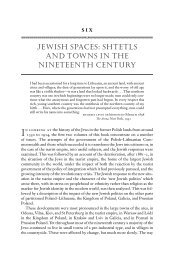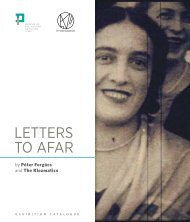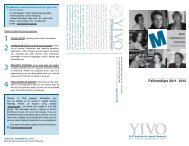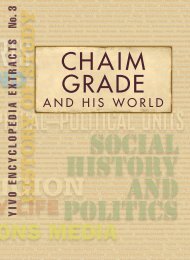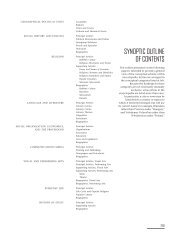You also want an ePaper? Increase the reach of your titles
YUMPU automatically turns print PDFs into web optimized ePapers that Google loves.
Anecdotal information suggests that<br />
many of Russia’s pioneer movie exhibitors<br />
and distributors were Jews; Jewish entrepreneurs<br />
were even more prominent in<br />
the early Polish and Hungarian cinemas.<br />
Between 1911 and 1913, approximately<br />
one-third of all Polish films were of Yiddish<br />
plays. The SiËa firm, owned by Warsaw<br />
exhibitor Mordka Towbin, filmed a<br />
number of productions staged by the<br />
Kaminski troupe—as did its successor<br />
Kosmofilm, Poland’s most important production<br />
company before World War I,<br />
founded by Towbin’s onetime partner<br />
Samuel Ginzberg and film-lab owner<br />
Henryk Finkelstein. Interest in the Yiddish<br />
stage extended to more established<br />
studios: in 1912, Pathé Frères Moscow<br />
adapted Sholem Asch’s Got fun nekome<br />
(God of Vengeance) and Moscow Gaumont<br />
produced Jacob Gordin’s Mirele<br />
Efros. In Riga, another center of Jewish<br />
filmmaking, the S. Mintus Company released<br />
at least seven productions made<br />
with Yiddish theatrical troupes.<br />
The most widely distributed Jewish<br />
film, however, was produced by the Mizrakh<br />
company in Odessa: Zhizn’ evreev v<br />
Palestine (The Life of Jews in Palestine)<br />
had its world premiere at the Eleventh Zionist<br />
Congress in Vienna before playing<br />
some 30 separate engagements throughout<br />
Europe and Russia; its extraordinary<br />
success inspired similar feature-length<br />
documentaries produced in Poland, one<br />
by Kosmofilm, and in Czechoslovakia.<br />
World War I and After<br />
Although World War I disrupted film<br />
production in the Russian Empire, Hungarian<br />
cinema boomed while French, Italian,<br />
and American imports were unavailable.<br />
Hungarian Jews deeply involved in<br />
the nation’s cultural life—particularly the<br />
nascent motion picture industry—included<br />
Mihály Kertész (later Michael<br />
Curtiz), who directed the first Hungarian<br />
feature film, and Sandor Korda (Alexander<br />
Korda), the leading Hungarian producer.<br />
Several Jewish-themed films were produced<br />
during this period, all with literary<br />
antecedents: Adolf Mérei’s Simon Judit<br />
(Judith Simon; 1915), based on the nineteenth-century<br />
ballad by Jewish poet<br />
József Kiss; Korda’s Lyon Lea (1915),<br />
adapted from Sándor Bródy’s play (later<br />
filmed in the United States as Surrender);<br />
Jenö Illés’ Szulamit (1916) from Avrom<br />
Goldfadn’s Yiddish operetta; Kertesz’s Az<br />
árendás zsidó (The Jewish Tenant Farmer;<br />
1917), from the folk drama by Szidor<br />
Bator, and Béla Balogh’s Israel (1918),<br />
332 CINEMA<br />
from Henry Bernstein’s play. Korda,<br />
Kertesz, and Balogh were all involved in<br />
the nationalized film industry of the<br />
short-lived Council Republic, and all<br />
three left Hungary after it fell in 1918.<br />
After the overthrow of the tsar in 1917,<br />
Mizrakh contributed to a brief revival in<br />
Russia of Jewish-themed pictures that included<br />
a dramatic reconstruction of the<br />
Beilis blood libel case, a film version of<br />
Evgenii Chirikov’s play Evrei (Jews), and<br />
several adaptations from Yiddish literature<br />
directed by Aleksandr Arkatov. The<br />
October revolution and ensuing Civil<br />
War again disrupted Russian filmmaking,<br />
although several short propaganda films<br />
produced in 1919 by the Mos-Kino-<br />
Komitet were specifically directed at Jewish<br />
audiences.<br />
Polish film production did not return<br />
to prewar levels until the early 1920s. In<br />
1921, Sfinks released Tajemnice Nalewek<br />
(Secrets of the Nalewki), which exposed<br />
poverty in Warsaw’s Jewish district. Òmierñ<br />
za Ûycie (Death Instead of Life; 1924) told<br />
the tale of a Jewish innkeeper’s son who,<br />
thanks to the friendship of a Polish<br />
prince, blossomed into a great national<br />
poet. More significant were the three<br />
movies produced by Leo Forbert, the<br />
owner of Warsaw’s largest photo lab, between<br />
1924 and 1929. Tkies kaf (The<br />
Handshake), the first and most successful,<br />
starred Ester-Rokhl Kaminska and her<br />
daughter Ida; it was followed in 1925 by<br />
Jeden z 36 (One of the 36) and an ambitious,<br />
ill-fated adaptation of Yosef<br />
Opatoshu’s novel Poylishe velder (The Polish<br />
Woods; 1929).<br />
The new Soviet film industry made the<br />
most programmatic attempt to develop<br />
a credible Jewish cinema. In 1925, a year<br />
after the state motion picture agency<br />
Sovkino was established, the Soviet<br />
Union’s two major Jewish theaters were<br />
involved in film production. Aleksandr<br />
Granovskii, the founder of the Moscow<br />
GOSET, directed Solomon Mikhoels in<br />
Evreiskoe schast’e (Yidishe glikn; Jewish<br />
Luck), which drew on Sholem Aleichem’s<br />
Menakhem Mendl stories and featured<br />
inter-titles written by Isaac Babel, while<br />
Sovkino invited members of the Hebrewlanguage<br />
Habimah to appear in the adaptation<br />
of Sholem Aleichem’s novel Der<br />
mabl (The Deluge).<br />
Subsequent Jewish-themed films were<br />
made under the auspices of the Ukrainian<br />
national studio VUFKU. These included<br />
two projects developed by Babel—Benia<br />
Krik (1926), based on his stories of<br />
Odessa’s Jewish underworld, and Bluzhdaiushchie<br />
zvezdy (Wandering Stars;<br />
1927), from Sholem Aleichem’s novel of<br />
the Yiddish theater Blonzhende shtern.<br />
Sholem Aleichem’s work also provided<br />
the theme for Grigorii Gricher-Cherikover’s<br />
Skvoz slezy (Through Tears; 1928).<br />
Given the substantial Jewish population<br />
of Ukrainian cities, VUFKU’s commit-<br />
Solomon Mikhoels (center) and other actors in Yidishe glikn (Jewish Luck), directed by Aleksandr<br />
Granovskii, USSR, 1925. (YIVO)<br />
MS3<br />
S<br />
R<br />
L



